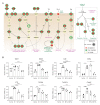Sappanone A Prevents Left Ventricular Dysfunction in a Rat Myocardial Ischemia Reperfusion Injury Model
- PMID: 32967328
- PMCID: PMC7555706
- DOI: 10.3390/ijms21186935
Sappanone A Prevents Left Ventricular Dysfunction in a Rat Myocardial Ischemia Reperfusion Injury Model
Abstract
The incidence of myocardial infarction, among the causes of cardiovascular morbidity and mortality, is increasing globally. In this study, left ventricular (LV) dysfunction, including LV systolic and diastolic function, was investigated in a rat myocardial ischemia/reperfusion injury model with echocardiography. The homoisoflavanone sappanone A is known for its anti-inflammatory effects. Using echocardiography, we found that sappanone A administration significantly improved LV systolic and diastolic function in a rat myocardial ischemia/reperfusion injury model, especially in the early phase development of myocardial infarction. Based on myocardial infarct size, serum cardiac marker assay, and histopathological evaluation, sappanone A showed higher efficacy at the doses used in our experiments than curcumin and was evaluated for its potential to improve LV function.
Keywords: acute myocardial infarction; coronary artery ligation; diastolic function; myocardial ischemia/reperfusion injury; sappanone A.
Conflict of interest statement
The authors have declared no conflict of interest.
Figures





References
-
- Jayaraj J.C., Davatyan K., Subramanian S.S., Priya J. Epidemiology of myocardial infarction. In: Pamukçu B., editor. Myocardial Infarction. IntechOpen; London, UK: 2018.
-
- Mor-Avi V., Lang R.M., Badano L.P., Belohlavek M., Cardim N.M., Derumeaux G., Galderisi M., Marwick T., Nagueh S.F., Sengupta P.P., et al. Current and evolving echocardiographic techniques for the quantitative evaluation of cardiac mechanics: ASE/EAE consensus statement on methodology and indications endorsed by the Japanese Society of Echocardiography. Eur. J. Echocardiogr. 2011;12:167–205. doi: 10.1093/ejechocard/jer021. - DOI - PubMed
-
- Lee K.S., Marwick T.H., Cook S.A., Go R.T., Fix J.S., James K.B., Sapp S.K., MacIntyre W.J., Thomas J.D. Prognosis of patients with left ventricular dysfunction, with and without viable myocardium after myocardial infarction. Relative efficacy of medical therapy and revascularization. Circulation. 1994;90:2687–2694. doi: 10.1161/01.CIR.90.6.2687. - DOI - PubMed
MeSH terms
Substances
LinkOut - more resources
Full Text Sources

